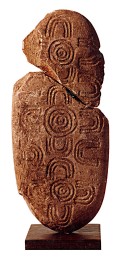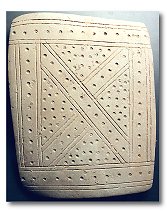|
| |
Major Aquisition:
Small voices from far away
The (almost) Invisible library
| #7 CHURINGA: A
PART OF THE ARANDA ABORIGINES' MYTHOLOGICAL LANDSCAPE
3 CAMPSITES, WATERHOLES OR TOTEM CENTRES (CONCENTRIC CIRCLES) WITH
PEOPLE SITTING FACING THE CENTRES, GUARDS FACING OUTWARDS (U-FORMS OF 3 LINES)

MS in Aranda on pinky weathered and worn chalk stone, Central Desert area, Australia,
aboriginal patterns incised with an incisor tooth of an opossum.
Commentary: There is no certain way to date the old churingas that are from the
pre- contact period (before 1780). They can be as old as the
Aboriginal culture, 40-50,000 years. With the earliest rockpaintings and carvings,
the cylcons and churingas represent the oldest form of communication and art, still
present, and they represent the oldest religion still observed. The aborigine owner's
belief is that his kuruna or spirit is intimately associated with his churinga. Even today
the whole of Australia is dotted over with Knanikillas, or local totem centres. Each of
these has a sacred storehouse for the tribe's and individuals' churingas, guarded by the
inkata. Women, and men that had not passed through the ceremonies of circumcision and
subincision, were not allowed to approach the storehouse, Pertalchera. The aborigine
people of the Central desert read the patterns on the churinga as representations of
nature, a kind of map or site. The icons are not literally figurative. Rather they can be
interpreted as a whole range of natural phenomena that are stereotyped in their typical
form, so they become an artistic system. Each churinga had its own personal
"name", which had to be sung whenever it was being inspected or handled. The
name was one of the verses from the sacred song cycle related to the actual totem centre. |
#8
DIVINATORY MANUAL OR STAR CHART? 
MS in Valdivian on grey limestone, Ecuador, 3500-1500 BC.
Context: From the Piguiga hoard. Dated to 3800-2800 BC.
Commentary: The Valdivian or pre-Valdivian stone plaques or star charts are the
earliest evidence of "writing" from the Americas.
The scholars disagree on their dates and meaning. The earliest dating is contemporary with
the earliest writing of Sumer and Egypt. The latest dating is about contemporary with the
earliest writing of Europe, Indus Valley and China.
The Valdivian culture flourished along the central coast of Ecuador, beginning in the
period 3000-2700 BC, persisting until about 1400 BC. Its pottery is one of the oldest in
the Americas. Its resemblance to the Jomon ware from Japan has led some scholars to
believe that it was introduced into Ecuador as a result of Trans-Pacific contacts.
|
 |
#9 NATIVE
NORTH AMERICAN GLYPHS WITH HUNTING, FISHING AND WHALING ILLUSTRATIONS
MS in Sugpiak on reindeer bone, South Alaska, ca. 18th c., 1 bow drill, 4 lines of
Eskimo glyphs and illustrations of herds of totally 45 caribou reindeer, 29 Eskimos
hunting with bow and arrow, fishing with a large net and from longboats, spearing a whale
from a longboat, and fish on drying rack.
The extremely detailed illustrations have many similarities to the much older
petroglyphs. |
| The Question: Today we recognize four stages of Piaget’s psychoanalytic and
cognitive development: a)
The symbiotic – in the first year of life, there is
no sense of a separation between subject and object (mother and child).
b)
The egocentric -- sensory-motor and preoperative phases of
development where the child succeeds in differentiating between self and environment, but
without a sense of differentiating between physical vs. social environments.
c)
The sociocentric-objectivistic – stage of concrete
operations where the child takes the step toward constructing a system of demarcation
between things and events, and understandable action-subjects and their utterances.
d) The
universalistic or "Formal operational" (abstract reasoning)– only in
adolescence does a person free herself from the dogmatism of the preceding phase and begin
to think hypothetically and conduct discourses. She
no longer accepts the validity claims contained in assertions and norms but transcends the
objectivism of a given nature. She begins to
see the given in the light of principles and criticize existing norms.
Piaget
has been criticized for asserting all human beings, regardless of culture, follow this
pattern of development. We now believe that logical and cognitive development is
more gradual and variable among certain groups or individuals. In fact, children
often combine stages and can flucuate between two stages. In light of education, how must
teachers respons to these scientific findings in relation to their students? |
|